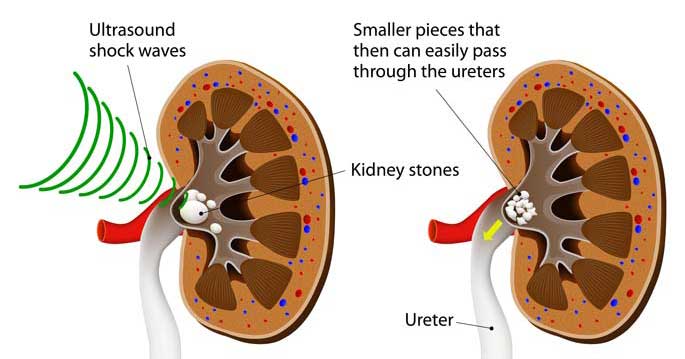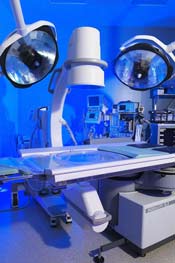Lithotripsy (ESWL)
Lithotripsy is a non-invasive surgical procedure used to treat kidney stones.
High-energy shock waves are transmitted from outside the body to break up kidney stones. The remaining kidney stone fragments are small enough that they can more easily pass through the urinary tract. Because lithotripsy is noninvasive and highly effective, it is one of the most common treatments for kidney stones in the United States.
The more formal name for lithotripsy is Extracorporeal Shock Wave Lithotripsy (ESWL).
- Extracorporeal means it occurs outside the body.
- Lithotripsy is from the Greek words for ‘stone’ (litho) and ‘crushing’ (tripsis).

When is lithotripsy used?
Kidney stones are usually small enough to pass through the urinary tract along with urine. In some cases, the stones are too large to pass on their own. Lithotripsy is normally used when:
• Stones are too large to pass (larger than 5 millimeters)
• Stones are blocking the flow of urine.
• Stones are causing bleeding or infection
• Pain medication isn’t effective when trying to pass stones
Some stones may be too large to treat with shockwave lithotripsy. The size, shape, location, and the number of stones will all be evaluated to see if this procedure is appropriate.
Your doctor may advise alternate treatment if you are pregnant, weigh over 300 pounds, have a pacemaker, kidney cancer, kidney infection, or on medications for cardiac conditions.
How is lithotripsy performed (what to expect)
Lithotripsy procedures are typically done as an outpatient procedure. Urology San Antonio performs most outpatient procedures at the
Pasteur Plaza Surgery Center (a division of Urology San Antonio).
Patients will be given a sedative or undergo general anesthesia for the procedure. Even though there are no incisions, the procedure could cause discomfort. It’s important for the patient to remain still and comfortable during the procedure, so some type of anesthesia is generally used.
The patient will lay on a procedure table where cushion filled with water will be placed near the area being treated. The body will be positioned so the device (known as a lithotripter) can deliver precise shockwaves to the appropriate area. It may take a couple thousand shockwaves to break up stones, so the process may take around an hour to complete.
Following the procedure, patients will usually spend a few hours in the recovery room at the surgery center before being released home.

Effectiveness of Lithotripsy
Around 3 out of 4 patients will be stone-free three months after lithotripsy treatment. If lithotripsy isn’t successful, the patient may need an endoscopic procedure to remove kidney stones.
Lithotripsy Recovery
You may or may not pass stone fragments until several weeks. In some rare cases, stone fragments may not pass for 1-2 months after treatment. After treatment:
• Drink lots of fluids! At least 8 glasses a day for several days, will help the fragments pass and decrease the amount of blood in urine
• Strain urine if requested by physician. Save all stone fragments at home and bring them to Urologist for analysis.
• Resume normal activity after 24 hours. Walking and mild exercise are beneficial, activity will help stone fragments pass.
• Take all medications as prescribed.
Common Symptoms After Lithotripsy
• Expect red-tined urine for at least 72 hours.
• You may notice slight bruising and redness on the treatment side/flank area
• Passing of stone fragments.
Call your urologist if you experience any of these problems:
• Red-tinged urine for longer than 72 hours or passing large blood clots with thick pasty urine.
• Severe pain that is not relieved by using prescribed pain medications.
• Fevers over 101.5° F
Frequently Asked Questions
Is lithotripsy painful?
Patients will undergo sedation or anesthesia during the procedure and may experience tenderness/bruising near the treatment area. Most patients are able to control discomfort with over-the-counter pain medications.
How long does a stent stay in after lithotripsy?
Some patients may have a stent placed to prevent blockage of the urine flow from stones or swelling of the ureter. The stent will be removed once enough time has passed to allow the swelling of the ureter to resolve. Your doctor will tell you when to return to have the stent removed.
Some patients may have a small thin black string coming out of the urethra (the tube your urine comes through). This string is connected to the stent and used to remove the stent when it is time for it to be removed. If this string retracts into the urethra and cannot be seen, do not worry. This is very common.
How long does it take for a kidney stone to pass after lithotripsy?
The stone fragments may pass in within a week but could take up to 4-8 weeks for all fragments to pass.
Quick Facts
Lithotripsy Doctors
Nearly all of Urology San Antonio’s doctors perform lithotripsy for kidney stones. To expedite your treatment, the urologist that performs your procedure may not be your primary urologist.
